35 Types of Pink Flowers (With Pictures)
-

- Last updated:
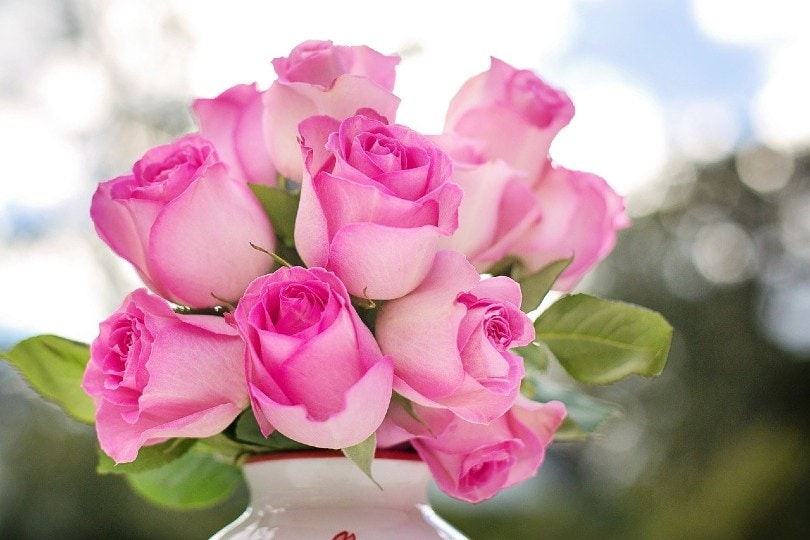
Pink flowers come in all shapes, sizes, and shades. In fact there are more than 100 species of pink flowers. They are perfect for table management, weddings, or bouquets. Pink flowers are the symbol of breast cancer awareness and represent love, hope, and grace. These are some of the most diverse flowers and embody femininity, rebirth, innocence, gratitude, and happiness.
Today, we’ll take a look at the best perennial, annual, and shrub pink flowers. So, if you’ve been looking for the perfect blossoms for a celebration, decoration, or a backyard garden, we’re confident that you’ll find just the right flowers in this following list. Pay extra attention to the blooming period, the recommended soil type, and, of course, the pics!
The 35 Types of Pink Flowers
Perennial Flowers
This term is used to describe flowers (or plants) with a lifespan of more than two years. They have a relatively short blooming period (three months tops; usually two to eight weeks) but regrow every spring. As long as the base and rootstock are intact (and well taken care of), you can cut the dead, above-ground stem and the flower will “come back to life”.
Now, if you want to see your garden blooming all-year-long—winter through fall—pick different flowers for each season. Most pink flowers are perennials, by the way. So, it should be hard to choose the right ones!
1. Alumroot
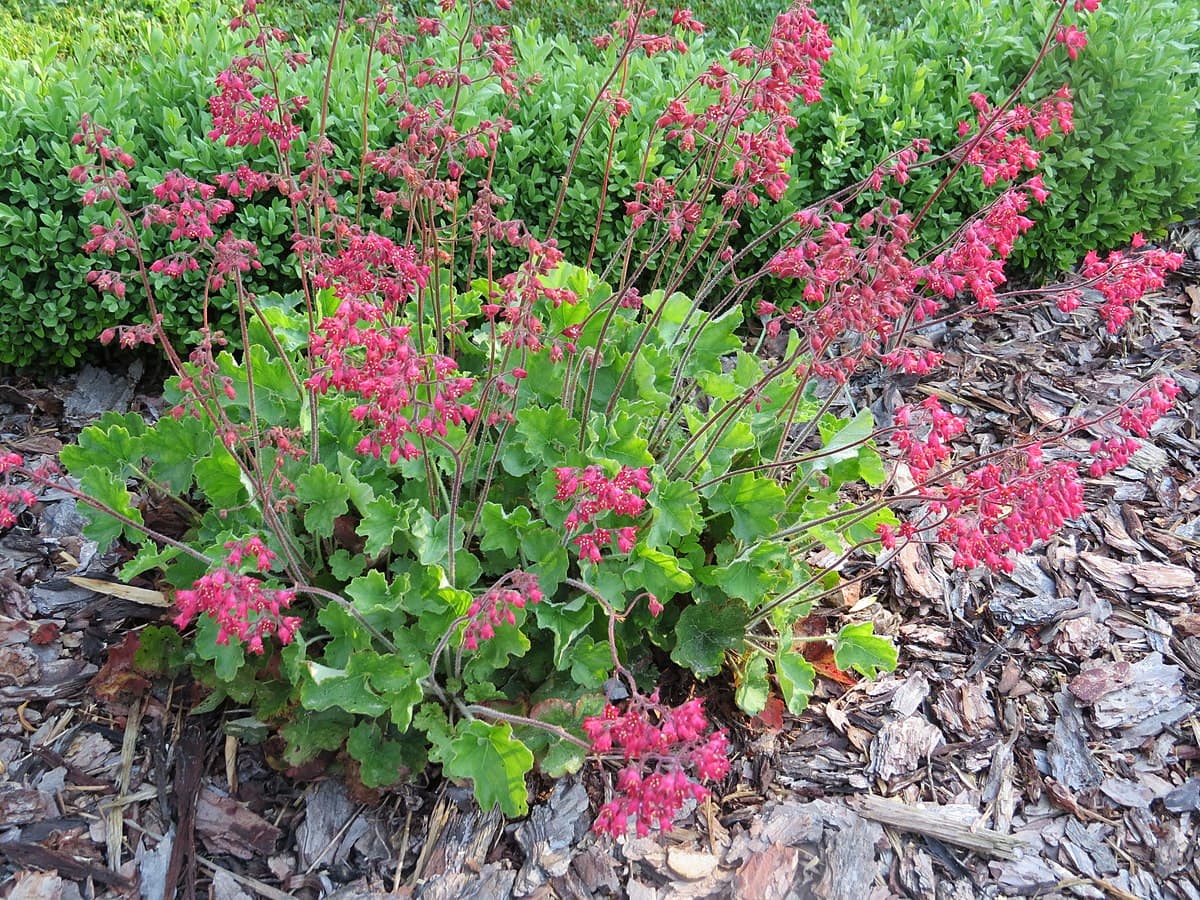
| Botanical Name | Heuchera |
| Soil | Well-drained (pH 6.8) |
| Sun | Full sun/partial shade |
| Hardiness Zone | 4–9 |
| In Bloom | Spring |
This small, yet captivating flower blooms in May and lasts up to June. Depending on the climate and the area that you live in, Alumroots can be either pink or red. They prefer full sun but also grow in partial shade. To achieve the best results, plant these flowers in well-drained soil. Ideally, it should be rich with humus. As for water, you won’t need lots of it. Just make sure the soil is moderately moist.
2. Aster

| Botanical Name | Symphyotrichum novi-belgii |
| Soil | Well-drained, moist (pH 5.1–5.5)) |
| Sun | Full sun/partial shade |
| Hardiness Zone | 4–8 |
| In Bloom | Late summer through early fall |
With a yellow center and beautiful pink petals, the Aster (“star” in Greek) is one of the most beautiful pink flowers. It can reach two inches in width and needs very little water to grow. We recommend planting Asters at least two months before frost so that you can see the fruits of your labor. These flowers grow equally well in full sun or partial shade and prefer moist, well-drained soil. The blooming period starts in summer (usually, in late August).
3. Beard Tongue
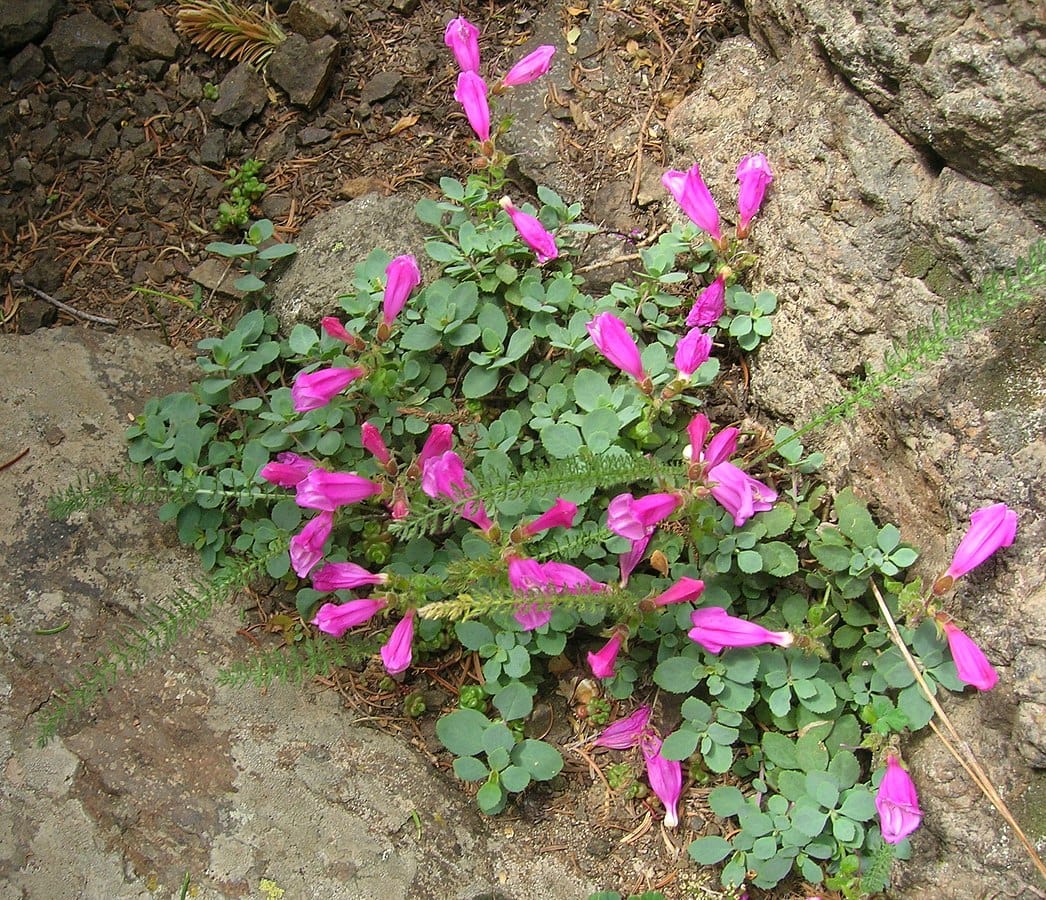
| Botanical Name | Penstemon |
| Soil | Well-drained, moist (pH 5.5–7) |
| Sun | Full sun |
| Hardiness Zone | 4–9 |
| In Bloom | Early summer |
Don’t let the funny name fool you: this is one of the most common and fan-favored pink flowers out there. And, it’s very easy to grow, as long as you expose it to full sun and keep the soil moist and well-drained. The Beard Tongue blooms in summer (sometimes, even earlier) and needs one to three weeks to germinate. It can be identified by the tight clusters and bell-like shape. To make it last longer, don’t forget about pruning.
4. Begonia

| Botanical Name | Begonia obliqua |
| Soil | Well-drained, light (pH 5.5–6.2) |
| Sun | Full sun/partial shade |
| Hardiness Zone | 9–10 |
| In Bloom | Early summer until frost |
Sometimes mistaken with roses, the Begonias are lush, captivating, and bloom in June, which makes them a perfect fit for a summer garden. To make sure they don’t die from frost, avoid planting these flowers in March or April (May is probably the perfect month for it). Equally strong in partial shade or in full sunlight, Begonia flowers blossom in well-drained, light soil. Their water needs are high, by the way: keep the soil nice and moist!
5. Blanket Flower
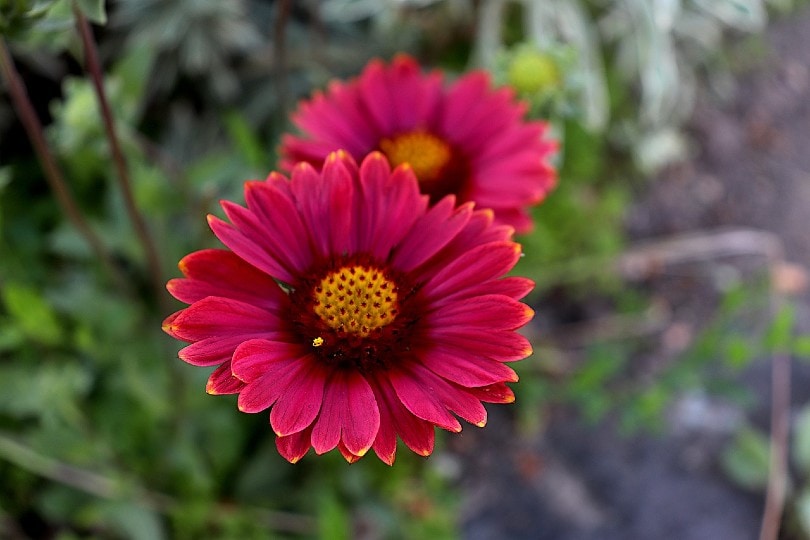
| Botanical Name | Gaillardia |
| Soil | Well-drained (no clay coil) (pH 6.1–6.5) |
| Sun | Full sun |
| Hardiness Zone | 3–9 |
| In Bloom | Summer through early fall |
Native to the American continent, the Blanket Flower is named after a famous botanist from the 18th century, Maître Gaillard. As for the common name, it refers to the blanket-like shape of the petals. Typically used for ornamentation, these flowers bloom in summer and “hang around” until the early days of fall. If you want to create perfect conditions, see that the soil is clay-free and well-drained and that the Blankets get lots of sunlight.
6. Bulbil Bugle-lily
| Botanical Name | Watsonia meriana |
| Soil | Well-composted (pH 5.5–6.5) |
| Sun | Full sun |
| Hardiness Zone | 8–10 |
| In Bloom | Spring |
There’s something majestic, otherworldly about these flowers, and that’s why they’re always in high demand. The bright color (which can also be orange, red, or white) is what makes Bulbil Bugle-Lily’s stand out. They bloom in spring and grow well in full sun and in well-composed soil. The water needs are moderate. This is an invasive species, one that comes from South Africa and is mostly used as an ornamental plant all across the globe.
7. Calla Lily
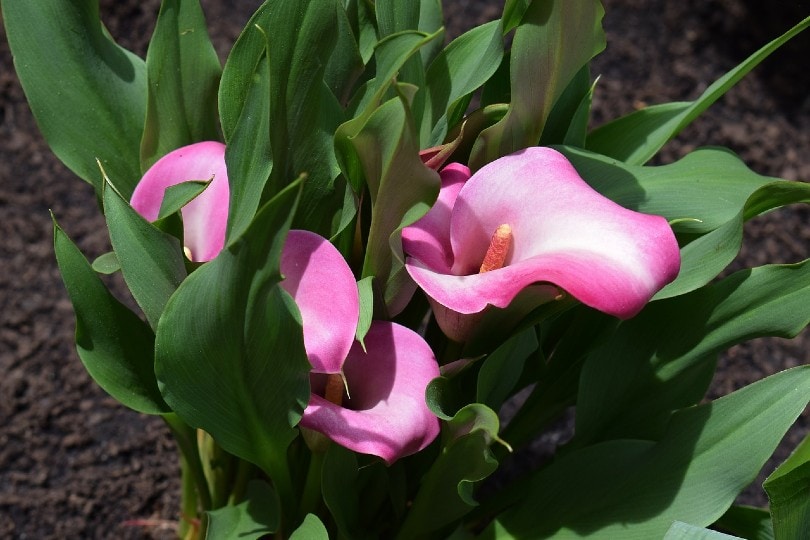
| Botanical Name | Zantedeschia |
| Soil | Well-drained, organically rich (pH 6.0–6.5) |
| Sun | Full sun/partial shade |
| Hardiness Zone | 8–10 |
| In Bloom | Late spring through summer |
The trumpet-like, spiky shape of the Calla Lily is eye-grabbing and very hard to miss. It represents innocence, while the flower blooms in late spring/early summer, and grows well in partial/full sun. Well-drained soil will do, but if you want this flower to truly prosper, the soil should be organically rich. The vivid, unique color is another big “selling point” of the Calla Lily and it easily fits in pretty much any garden. It does need lots of water, though.
8. Carnation
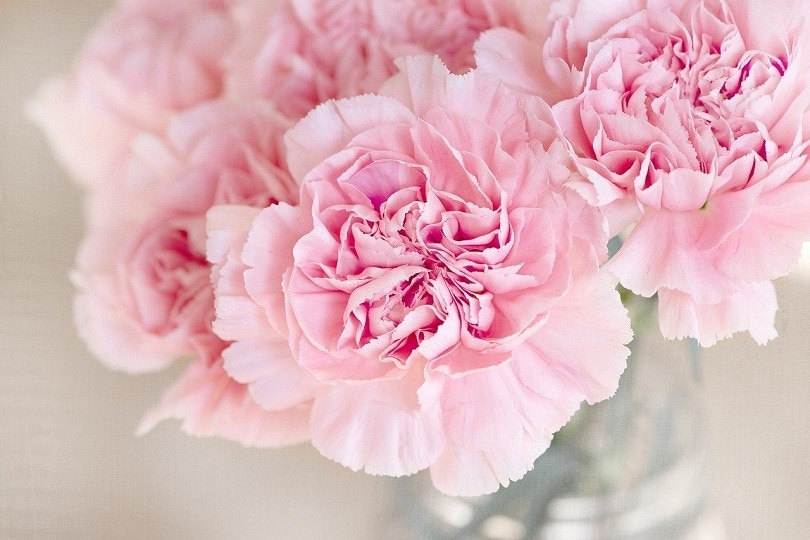
| Botanical Name | Dianthus caryophyllus |
| Soil | Well-drained, fertile (pH 6.7) |
| Sun | Full sun |
| Hardiness Zone | 3–9 |
| In Bloom | Late spring through mid-summer |
Thanks to the longer-than-average blooming period (up to two months, or more) and distinctive shape, the Carnation is quite popular. It has been cultivated by our species for over 2000 years and dates back to the Greeks and Romans. And, as long as the soil is fertile and well-drained, and you water these flowers at least once a week or so, they’ll grow pretty quickly and turn your garden into a masterpiece. Full sunlight is preferred.
9. Chrysanthemum
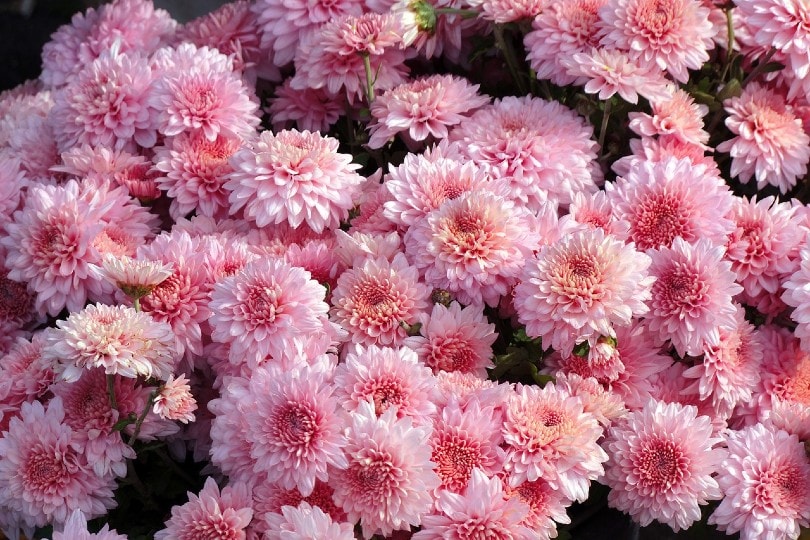
| Botanical Name | Chrysanthemum |
| Soil | Well-drained, sandy (pH 6.5) |
| Sun | Full/partial sun |
| Hardiness Zone | 5–9 |
| In Bloom | Late summer through fall |
This flower symbolizes love and happiness, and, in contrast to most pink flowers, it can grow in late autumn. When properly taken care of, the Chrysanthemum can even bloom in early winter. That’s what makes it somewhat unique and in large demand during the colder days. Some experts claim it has medical properties and helps with digestion, throat pains, and more.
Originally from China, Chrysanthemums can grow pretty much anywhere and benefit from sandy, well-drained soil, full sun/shade, and consistent watering.
10. Clematis
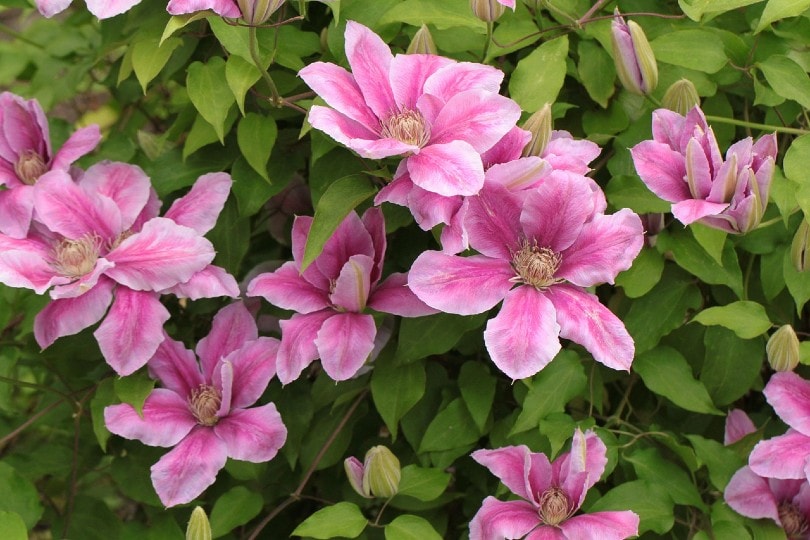
| Botanical Name | Clematis/Pink Fantasy |
| Soil | Well-drained, moist (pH 6.0–7.0) |
| Sun | Full sun/partial shade |
| Hardiness Zone | 4–8 |
| In Bloom | Late spring through early summer |
You’ve probably already seen these flowers once or twice, as they’re trending among the fans of adaptable, eye-catching blossoms. They look like seven-pointed stars and will be a great addition to any garden (or celebration). Like most perennials, the Clematis blooms in late spring and shows steady growth no matter how much sun it gets. The most important thing here is to keep the soil moist and to make sure the ground is frost-free before planting it.
11. Coneflower
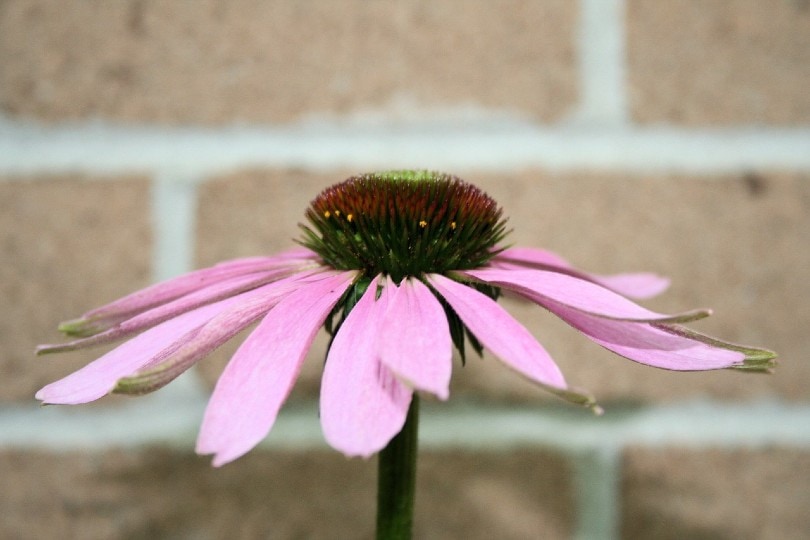
| Botanical Name | Echinacea |
| Soil | Well-drained, sandy, or clay (pH 6.0–7.0) |
| Sun | Full sun |
| Hardiness Zone | 5–9 |
| In Bloom | Mid-summer through mid-fall |
Named after the big, brown cones, these pink flowers are mostly found in prairies. The blooming period is June through September/October—much longer than the average for perennials. Easy to grow and maintain, they’re best cultivated in well-drained, sandy soil (or even clay). If you’re looking for a no-hassle type of flower for your garden, and you’ve got enough sun exposure in summer, Coneflowers might be a perfect choice.
Moderate watering is the way to go here.
12. False Goat’s Beard

| Botanical Name | Astilbe |
| Soil | Well-drained, moist, and composted (pH 6.0) |
| Sun | Partial shade |
| Hardiness Zone | 4–8 |
| In Bloom | Late-spring mid-summer |
The color and especially the shape of this flower look very much like a beard, and that’s where the name comes from. The leaves tend to be quite dull, but they do look great regardless of the hue. Partial shape, moderate watering, and moist, composted soil—that’s all you’re going to need to successfully grow False Goat’s Beards in your backyard. Resistant to early frost, they bloom for up to six weeks. Plus, they get as big as five feet tall!
13. Hollyhock

| Botanical Name | Alcea rosea |
| Soil | Well-drained (pH 6.0–8.0) |
| Sun | Full sun |
| Hardiness Zone | 3–8 |
| In Bloom | Summer |
They say that if you stare at a Hollyhock, it can hypnotize you. This is an old legend, of course, but the flower does, indeed, look mesmerizing. It blooms in summer and grows on long stalks. If you plant enough Hollyhocks in your garden, the view will be simply astonishing! To do that, get some well-drained soil and do your best to expose the flowers to full sun. These are biennial plants and only flower in the second year.
14. Hyacinth

| Botanical Name | Hyacinthus |
| Soil | Well-drained, loose (pH 6.0–7.0) |
| Sun | Partial sun |
| Hardiness Zone | 4–9 |
| In Bloom | Early to mid-spring |
These marvelous flowers can reach 10 inches in length and flourish in partial shade/sun. The soil should be well-drained and loose, while the watering needs are moderate. Depending on the species, you might have to be a bit patient with the Hyacinth, but once the star-shaped flowers “poke through”, it will be all worth it. We recommend planting the bulbs in mid-fall. That way, the flowers will bloom in early spring.
Oh, and remember: the bulbs are poisonous! So, don’t forget to put your favorite garden gloves on before handling them.
15. Lady’s Slipper Orchids

| Botanical Name | Cypripedioideae |
| Soil | Well-drained, well-aerated (pH 6.5–7.0) |
| Sun | Partial shade |
| Hardiness Zone | 1–11 |
| In Bloom | Early to mid-summer |
The next pink flowers on our list grow even taller (up to 15 inches) and look more like a tiny fruit than anything else. As long as the soil is well-aerated and well-drained, and the flowers get partial shade, you won’t have to wait long before the Orchids take shape. It does take some effort and skills to grow them, but if you add some fertilizer into the mix (and maybe a healthy dose of fluorescent light), it shouldn’t really be a problem.
16. Lily of the Incas

| Botanical Name | Alstroemeria |
| Soil | Well-drained, rich (pH 7.0) |
| Sun | Full sun/partial shade |
| Hardiness Zone | 8–10 |
| In Bloom | Summer |
The shape of these flowers is pretty standard, but the beautiful mix of various colors is what makes them truly stand out. The Incas can grow both indoors and outdoors. However, they don’t tolerate frost (because they’re native to South America), which means you gotta bring them home before the cold days start. Rich soil, partial sunlight, and moderate water (maybe a bit more when you’re just planting it) are all the Peruvian Lily needs to grow.
17. Lotus
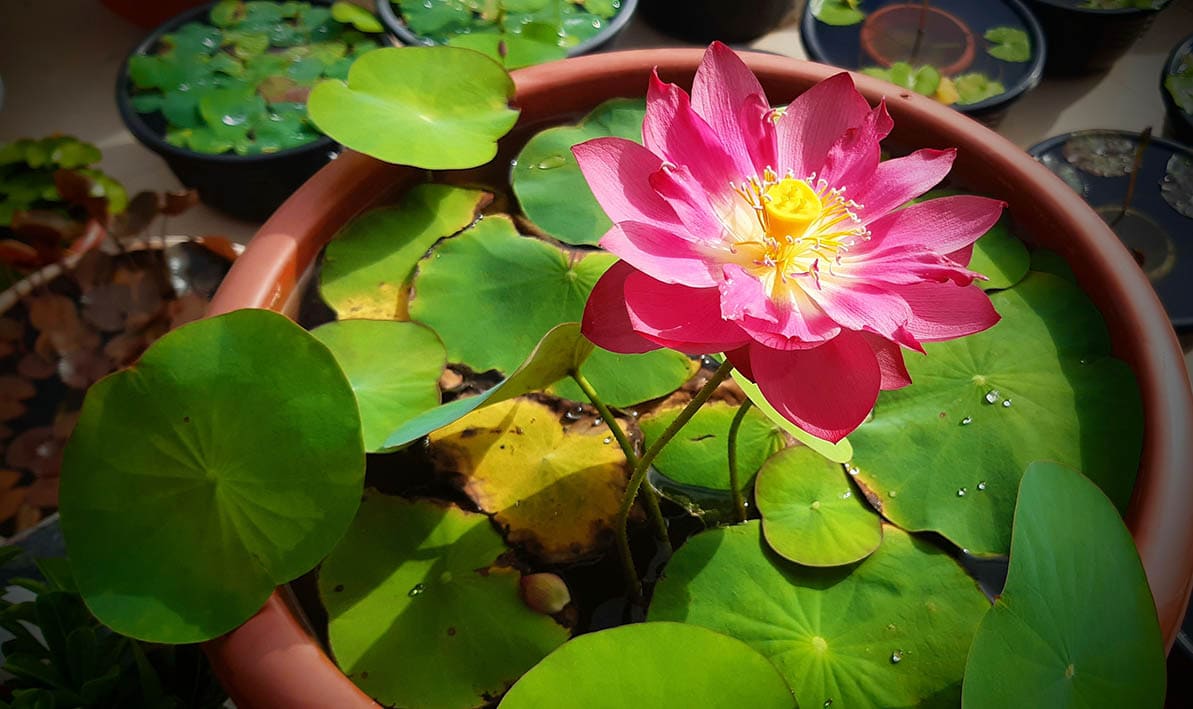
| Botanical Name | Nelumbo nucifera |
| Soil | Clay, sand gravel (pH 4.5) |
| Sun | Full sun |
| Hardiness Zone | 4–12 |
| In Bloom | Summer |
Wait, doesn’t the Lotus only grow on water? Technically, yes, but nothing’s stopping you from planting one in a container. Go with a gravel/clay and water mix, and this beauty will flourish just fine. It blooms in summer and benefits from exposure to full sunlight. Of course, if you have a pond in the garden, you can grow the Lotus there. A quick note: these flowers are sacred to Buddhist monks as they symbolize resilience and enlightenment.
18. Oriental Lily
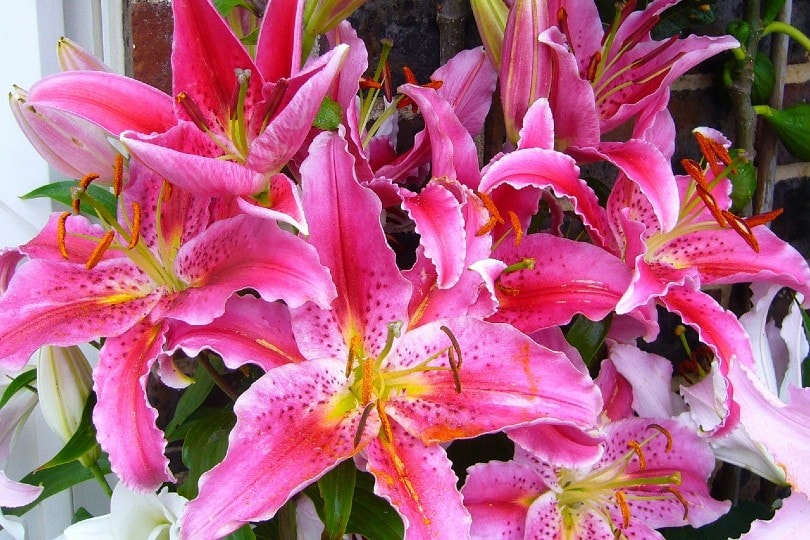
| Botanical Name | Lilium orientalis |
| Soil | Well-drained, rich, moist (pH 6.5–6.9) |
| Sun | Full sun/partial shade |
| Hardiness Zone | 4–9 |
| In Bloom | Late summer through early fall |
Also known as the Stargazer, this is one of the most extraordinary pink flower types on planet Earth. Sadly, the blooming period is incredibly short (mostly, it’s late August) and only lasts until mid-September. Still, Oriental Lily deserves a spot on the list. It requires little care and survives through partial shade and moderate water supplies. But, it would be best if you “feed” it with rich, moist, and well-drained soil for quick results.
19. Oriental Poppy

| Botanical Name | Papaver orientale |
| Soil | Well-drained, composted (pH 6.5–7.0) |
| Sun | Full sun |
| Hardiness Zone | 3–9 |
| In Bloom | Late spring to early summer |
Despite the similarities in their names, the Oriental Lily and Poppy don’t have much in common. Poppy blooms in late May and requires very little water to flourish; full sunlight would be great, though. The soil needs to be well-drained (like with most flowers) and composted. This is important: Oriental Poppies have a short lifespan and wither relatively quickly.
They are true perennials, though; that means they’ll grow back next summer and look even more beautiful.
20. Periwinkle
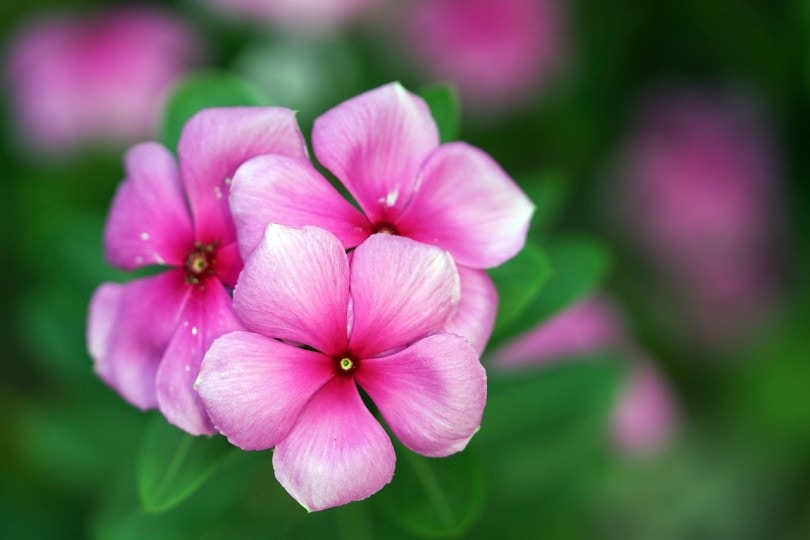
| Botanical Name | Vinca |
| Soil | Well-drained, moist (pH 6.0–7.5) |
| Sun | Full sun/partial shade |
| Hardiness Zone | 4–9 |
| In Bloom | March-April (or early fall) |
Simple in design and pretty short (only six inches tall), the Periwinkles are quite common in the US. As long as they get partial shade, reasonable amounts of water, and decent-quality soil, you’ll see lots of Periwinkle’s in your garden in the blink of an eye. That happens in mid-March, by the way. Sometimes, these flowers “regenerate” in September.
Temperature plays a key role in this: depending on how cold or warm it is, the Periwinkles will grow in different periods.
21. Petunia

| Botanical Name | Petunia atkinsiana |
| Soil | Fast-draining, fertile (pH 6.0–7.0) |
| Sun | Full sun |
| Hardiness Zone | 9–11 |
| In Bloom | Late spring until frost |
In a way, Petunias look like Periwinkles. They’ve got a similar hue, petal structure, and more. You’ll need fast-draining (and preferably fertile) soil for these flowers, though, and full exposure to the sun. The best thing about Petunias—they grow back every 12 months with minimal effort on your side and make the garden look really “expensive”.
Bright and colorful, these flowers also add a nice fragrance, especially if you grow them indoors in containers.
22. Pink Rose
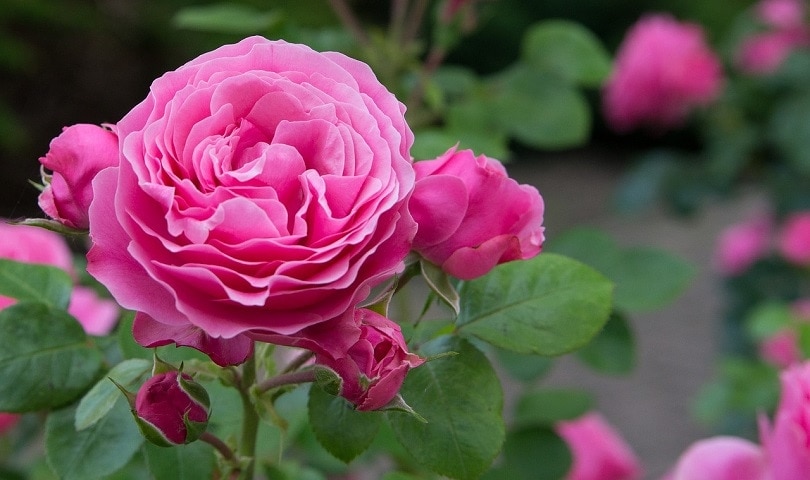
| Botanical Name | Rosa |
| Soil | Well-drained (pH 5.5–7.0) |
| Sun | Full/partial sun |
| Hardiness Zone | 4–9 |
| In Bloom | Mid-spring to early fall |
Who doesn’t like roses, right? These are probably the most glorified and hailed flowers in the history of mankind. They grow in pretty much every corner of the planet and serve as perfect gifts (and not only to a loved one). To be successful at growing pink roses, you won’t need much: moderate water, well-drained soil, and full or partial sun. Roses have an above-average lifespan, bloom in April-May, and last until the first frost (mid-September).
23. Ranunculus
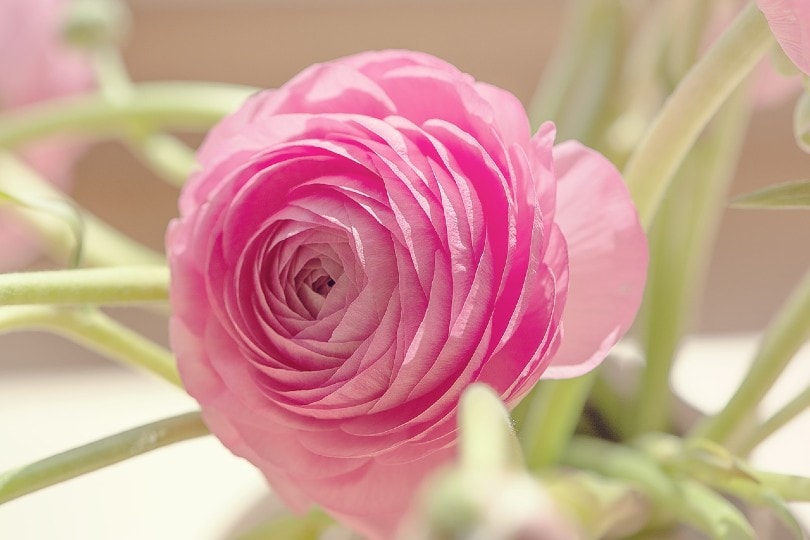
| Botanical Name | Ranunculus |
| Soil | Well-drained, light (pH 6.0–6.5) |
| Sun | Full sun |
| Hardiness Zone | 8–11 |
| In Bloom | Late winter/early spring |
To an amateur, the Ranunculus looks a lot like roses; however, it’s a different flower. The seeds might not seem like much, but if you water them once a week, expose them to full sunlight, and make sure the soil is light and well-drained, these beautiful flowers will turn your garden into a sight for sore eyes. If you live in a warm area, plant the flowers in the fall (October would be great) to allow the Ranunculus to bloom in March-April.
24. Statice
| Botanical Name | Limonium |
| Soil | Well-drained (pH 5.5–6.5) |
| Sun | Full sun |
| Hardiness Zone | 9–11 |
| In Bloom | Summer |
Full sun, low water, and a relatively warm climate—that’s pretty much all the Statice flowers need to sprout. They take little time to mature (30 days max), and the best month to plant them is in early July. Statices look spectacular when they grow in numbers and cover the entire garden. Another big pro: the blooming period is quite long and you’ll get to enjoy these tiny pink flowers through fall (up to mid-November).
25. Yarrow
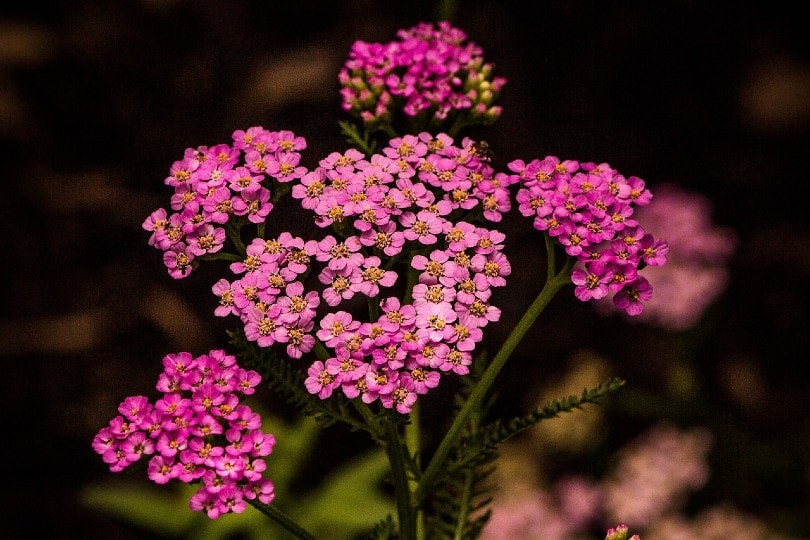
| Botanical Name | Achillea |
| Soil | Well-drained, sandy, or clay (pH 4.7–8.0) |
| Sun | Full sun |
| Hardiness Zone | 3–9 |
| In Bloom | Late spring/early summer |
Are you in the market for big (two-feet-tall), low-maintenance pink flowers? Then Yarrows might be right up your alley. They bloom in a warm climate (mostly, during the early days of summer) and add a unique, lovely touch to any garden. Yarrows are resistant to drought and can grow in sandy soil or even clay. Yes, this is a highly resistant species. As long as they’ve got enough sunlight, you won’t have to do much to help them blossom.
Annual Flowers
Some folks think that “annual” means these flowers stay in bloom 365 days a year, but that’s not really it. True, annuals do grow and prosper for one full, long season, but they don’t re-grow. Unfortunately, they die in the winter season. The exact date depends on when the air temperature drops below the freezing point (32 ºF/0 ºC). With that said, some types of annual flowers do drop seeds that can be used for regrowth.
26. Cosmos
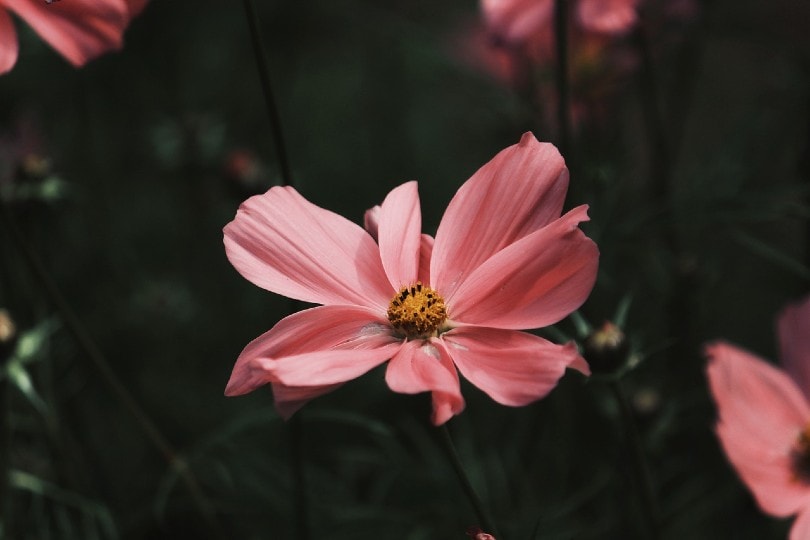
| Botanical Name | Cosmos sulphureus |
| Soil | Well-drained, slightly acidic (pH 6.5–7.0) |
| Sun | Full sun |
| Hardiness Zone | 3–10 |
| In Bloom | Early summer until frost |
At a glance, it may seem that we’ve got daisies here, but it’s actually the Cosmos flowers. They’re pretty tiny, pink, and like to be exposed to the sun and lots of water. Just like most annuals, these flowers have an extended blooming season. So, if this sounds like a good idea for your garden, prepare well-drained, acidic soil and start growing the seeds as early in summer as you can to enjoy the Cosmos for the whole season.
27. Dahlia
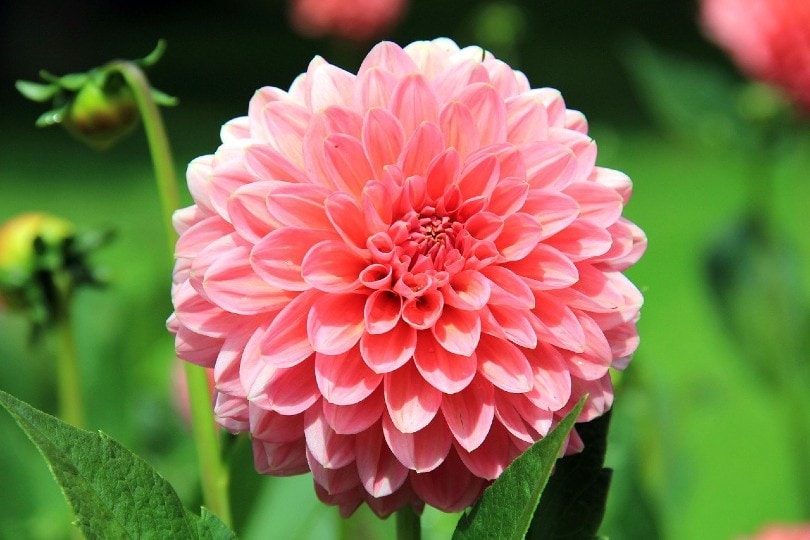
| Botanical Name | Dahlia pinnata |
| Soil | Well-drained, rich (pH 6.5–7.0) |
| Sun | Full sun |
| Hardiness Zone | 8–11 |
| In Bloom | Mid-summer through early fall |
Doesn’t the Dahlia look like a sea creature or something like that? However, once you get closer, you’ll see the bright pink petals and the dome-like structure that many people around the world love. Originally from Mexico, it represents grace. With full sun, rich soil, and low-to-moderate watering, the Dahlia will bloom through July up to mid-September (or until the temperature drops to zero), which is pretty much all one can ask from an annual flower.
28. Larkspur
| Botanical Name | Delphinium |
| Soil | Well-drained, light (pH 5.5–7.0) |
| Sun | Full sun/partial shade |
| Hardiness Zone | 2–8 |
| In Bloom | Spring |
Here, we have another pink flower type with an unusual, attention-grabbing petal design. The bottom of the step is practically “naked”, with all of the flowers growing at the very top. Larkspurs bloom in spring and prefer light soil and moderate exposure to sunlight (the same is true for water). To successfully grow more than one Larkspur in your garden, make sure there’s enough space (a gap) between each stem (12 inches should do the trick).
29. Tulip
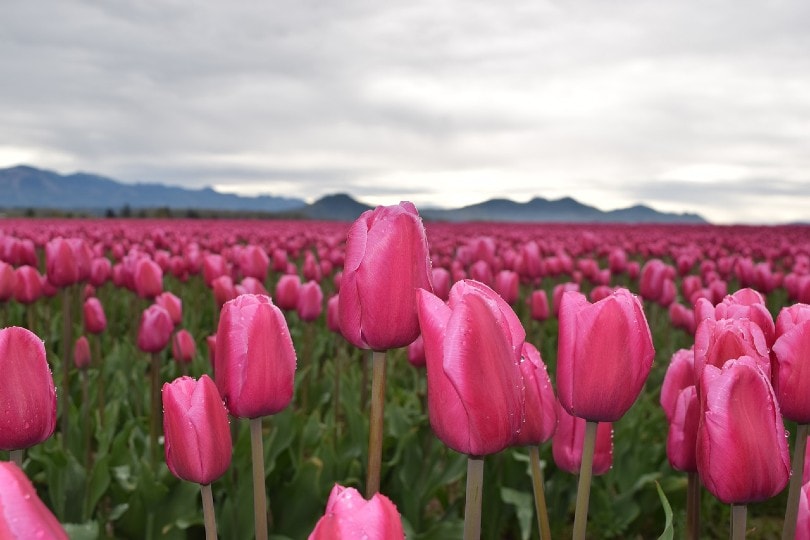
| Botanical Name | Tulipa |
| Soil | Well-drained, sandy, and organic (pH 6.0–7.0) |
| Sun | Full sun |
| Hardiness Zone | 4–10 |
| In Bloom | Spring |
Originally from Central Asia, Tulips are, undoubtedly one of the most popular flowers in the United States and Europe, all thanks to the cup-shaped petals and beautiful pink color. These days, they’re mostly being produced in Holland. So, if you want to grow your own Tulipas in the backyard, see that the soil is sandy, organic, and well-drained, with lots of sunlight helping the stems sprout.
Tulips bloom in early/mid-spring (mostly, in March) but, sadly, whither rather quickly.
30. Zinnia

| Botanical Name | Zinnia elegans |
| Soil | Well-drained, rich, organic (pH 5.5–7.5) |
| Sun | Full sun |
| Hardiness Zone | 3–10 |
| In Bloom | Late spring through early fall |
Unless you’re from South America or live in Southwestern US, you’ve probably never seen the Zinnia. That’s because it mostly grows in Mexico. This annual flower loves full exposure to sun, organic, rich soil, and little portions of water, but, overall, it’s highly resistant to heat and drought. It blooms in mid-May and lasts up to late September, depending on how warm it is.
Zinnia flowers come in different shapes and can have single or double rows of petals.
Shrub Flowers
Alright, with perennials and annuals out of the way, let’s check out the most beautiful pink flowering shrubs. Sometimes, shrubs are called bushes, but, technically speaking, they are plants with woody stems. They can be either evergreen or deciduous. So, what sets them apart from trees? The height, of course (30 ft. max), along with the number of stems: it’s much higher than on any tree.
As for longevity, shrubs usually last +/- five years, while some rare species live up to 70+ years.
31. Azalea
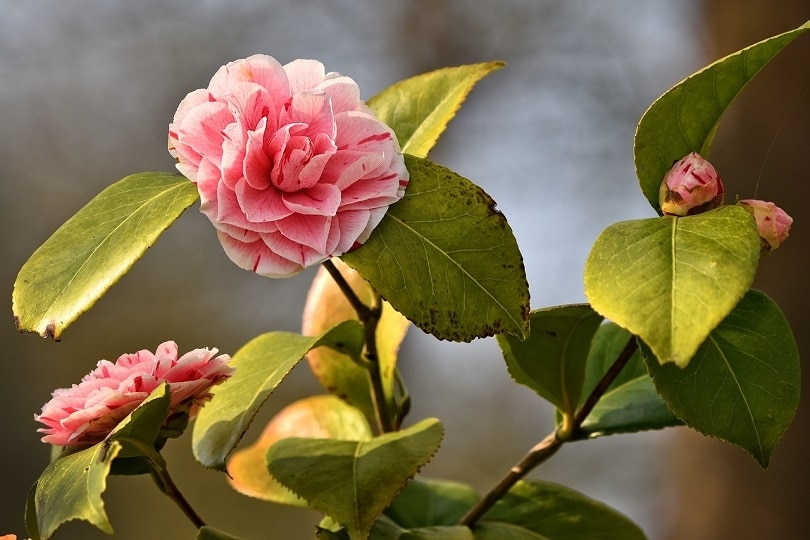
| Botanical Name | Rhododendron |
| Soil | Well-drained (pH 4.5–6.0) |
| Sun | Partial sun |
| Hardiness Zone | 6–9 |
| In Bloom | Spring through summer |
Depending on the climate and the temperature, the Azalea petals can have a wide range of beautiful pink semitones. These flowers have the shape of a bell, bloom in early spring, and symbolize femininity. Partial sun and well-drained soil are enough for the Azaleas to grow properly. A quick tip: water them deeply, but only once a week or so. Thanks to the shrub nature, these flowers serve as great “privacy walls” for your yard.
32. Butterfly Bush
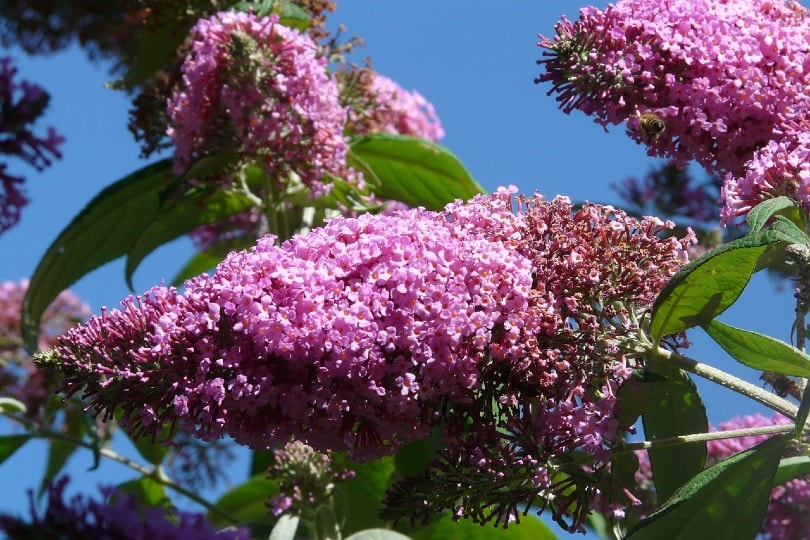
| Botanical Name | Buddleja |
| Soil | Well-drained (pH 6.0–7.0) |
| Sun | Full sun/partial shade |
| Hardiness Zone | 8–10 |
| In Bloom | Mid-summer through early fall |
These next flowering shrubs grow in large clusters and attract butterflies and other insects, hence the name. On their own, the Buddleja flowers might not look very exciting. However, when there’s a whole field of them, that’s an entirely different story. Butterfly Bushes bloom in June and survive up to early fall. Water them thoroughly once in seven days, make sure the soil is well-drained, and you’ll be rewarded with a beautiful sight in the garden!
33. Hibiscus

| Botanical Name | Hibiscus rosa-sinensis |
| Soil | Well-drained, moist (pH 6.5–6.8) |
| Sun | Full sun |
| Hardiness Zone | 5–9 |
| In Bloom | Summer |
The extraordinary long “tail” (scientifically known as a protruding stamen) is, most definitely, the one thing that puts the Hibiscus apart from the rest of the pink flower family. Originally from the Pacific Rim area, it has an incredible scent that is used in many fragrances. On top of that, the Hibiscus is often added to food and drinks for that special flavor. It blooms in summer and grows fast in moist soil and in full sun.
34. Hydrangea
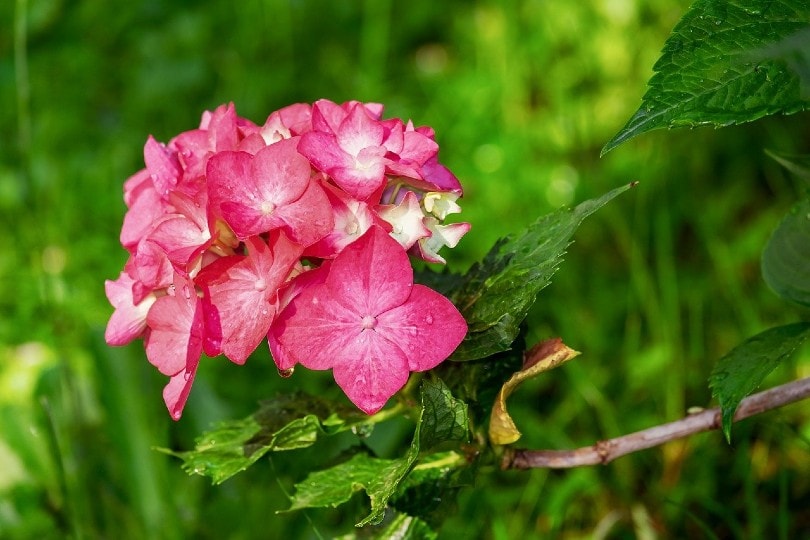
| Botanical Name | Hydrangea angustipetala |
| Soil | Sandy, organic, with peat moss (pH 5–6) |
| Sun | Partial shade |
| Hardiness Zone | 6–10 |
| In Bloom | Early spring through mid-summer |
Are you looking to add some pick colors to your garden? If the answer is yes, Hydrangeas could very well be an excellent choice. These plant-like flowers bloom in partial shade and grow rapidly in organic, sandy soil rich with peat moss. The flowers are pretty large, symbolize true feelings and require lots of water to blossom. The best use for the Hydrangea flower is, of course, festivals and celebrations (like a wedding or something like that).
35. Peony
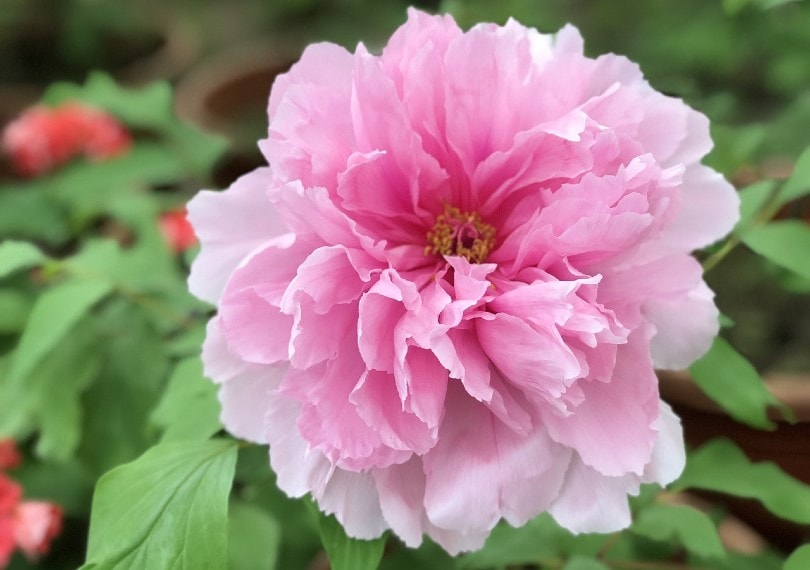
| Botanical Name | Petunia |
| Soil | Well-drained, slightly acidic (pH 6.5–7.0) |
| Sun | Full sun |
| Hardiness Zone | 4–9 |
| In Bloom | Early spring through mid-summer |
The last stop for us today is the Peony flower. It grows in most continents, including America, Europe, and Asia. Peony represents honor and good fortune and blooms in early spring (usually, in the second half of April). One of the best things about this plant: it can go on for up to 100 years (!) and still be fertile. These flowers are great for weddings, ornaments, decorations, and growing in your garden for personal use.
In Conclusion
Alright, that is it for today! We just checked out 35 marvelous pink flowers that can light up the mood, breathe new life into your garden, or decorate a festivity. While they do, of course, require special care, you won’t have to spend much time (or lots of money) to grow these blossoms. Just follow our recommendations for the zones, sun exposure, and soil, and you’ll be golden!
Enjoy your new pink flowers, and check back with us more often for the latest posts!
Featured Image Credit: JillWellington, Pixabay
Contents

